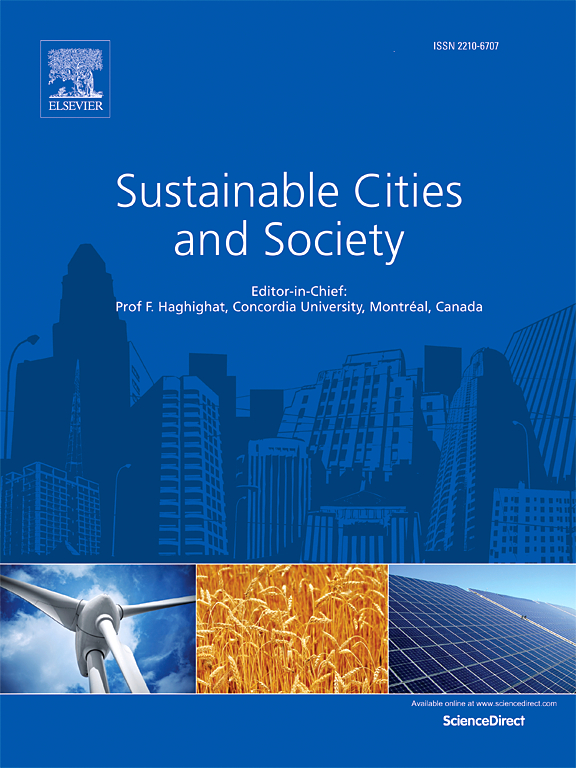Unlocking Urban Ecological Resilience: The Dual Role of Environmental Regulation and Green Technology Innovation
IF 10.5
1区 工程技术
Q1 CONSTRUCTION & BUILDING TECHNOLOGY
引用次数: 0
Abstract
The growing complexity and dynamism of the environmental challenges driven by rapid urbanization pose significant risks to achieving sustainable development goals, highlighting the urgent need to assess urban ecological resilience (UER). This paper aims to evaluate the influence of environmental regulation (ER) and green technology innovation (GTI) on UER, particularly focusing on understanding their interactive effects. Using a resistance‒adaptability‒resilience (RAR) theoretical framework, we construct a UER evaluation system categorized into four dimensions: driving, resistance, adaptability and resilience (DRAR). This paper applies the entropy‒weight TOPSIS (EW‒TOPSIS) method combined with system GMM (SYS‒GMM) estimation to evaluate how ER and GTI impact UER across 247 China's prefecture‒level cities from 2010‒2022. The key findings included the following: (1) UER exhibited an upward trend from 2010‒2022, with a narrowing gap between cities and a westward decreasing trend; (2) ER hindered the increase in UER during this period; (3) further mechanism analysis revealed that ER indirectly reduced UER by weakening GTI; (4) regional heterogeneity analysis revealed that ER exhibits a robust negative association with UER in China's eastern, central, and northeastern zones, while western region shows positive statistically significant ER‒UER linkage; and (5) resource heterogeneity analysis indicated that ER demonstrates a significant negative correlation with UER in resource‒based cities and non‒resource‒based cities. This paper offers valuable insights into how ER and GTI influence UER. Policymakers should implement differentiated ER and innovation‒driven strategies to establish mechanisms for enhancing UER that promote regional coordination, policy synergy, and technological integration.
解锁城市生态弹性:环境规制与绿色技术创新的双重作用
快速城市化推动的环境挑战日益复杂和动态,对实现可持续发展目标构成重大风险,凸显了评估城市生态弹性(UER)的迫切需要。本文旨在评价环境规制(ER)和绿色技术创新(GTI)对用户效率的影响,特别是了解它们之间的相互作用。运用阻力-适应性-弹性(resistance - adaptive - resilience, RAR)理论框架,构建了驱动、阻力、适应性和弹性(DRAR)四个维度的UER评价体系。本文采用熵权TOPSIS (EW-TOPSIS)方法结合系统GMM (SYS-GMM)估计方法,对2010-2022年中国247个地级市的gdp和GTI对gdp的影响进行了研究。结果表明:①2010-2022年,城市间UER呈上升趋势,城市间差距逐渐缩小,城市间UER呈西向下降趋势;(2) ER在此期间阻碍了UER的增加;(3)进一步的机理分析表明,ER通过削弱GTI间接降低了UER;(4)区域异质性分析表明,东部、中部和东北部地区ER与UER呈显著负相关,西部地区ER与UER呈显著正相关;(5)资源异质性分析表明,资源型城市和非资源型城市的ER与UER呈显著负相关。本文对ER和GTI如何影响UER提供了有价值的见解。政策制定者应实施差别化、创新驱动战略,建立促进区域协调、政策协同和技术融合的用户效益提升机制。
本文章由计算机程序翻译,如有差异,请以英文原文为准。
求助全文
约1分钟内获得全文
求助全文
来源期刊

Sustainable Cities and Society
Social Sciences-Geography, Planning and Development
CiteScore
22.00
自引率
13.70%
发文量
810
审稿时长
27 days
期刊介绍:
Sustainable Cities and Society (SCS) is an international journal that focuses on fundamental and applied research to promote environmentally sustainable and socially resilient cities. The journal welcomes cross-cutting, multi-disciplinary research in various areas, including:
1. Smart cities and resilient environments;
2. Alternative/clean energy sources, energy distribution, distributed energy generation, and energy demand reduction/management;
3. Monitoring and improving air quality in built environment and cities (e.g., healthy built environment and air quality management);
4. Energy efficient, low/zero carbon, and green buildings/communities;
5. Climate change mitigation and adaptation in urban environments;
6. Green infrastructure and BMPs;
7. Environmental Footprint accounting and management;
8. Urban agriculture and forestry;
9. ICT, smart grid and intelligent infrastructure;
10. Urban design/planning, regulations, legislation, certification, economics, and policy;
11. Social aspects, impacts and resiliency of cities;
12. Behavior monitoring, analysis and change within urban communities;
13. Health monitoring and improvement;
14. Nexus issues related to sustainable cities and societies;
15. Smart city governance;
16. Decision Support Systems for trade-off and uncertainty analysis for improved management of cities and society;
17. Big data, machine learning, and artificial intelligence applications and case studies;
18. Critical infrastructure protection, including security, privacy, forensics, and reliability issues of cyber-physical systems.
19. Water footprint reduction and urban water distribution, harvesting, treatment, reuse and management;
20. Waste reduction and recycling;
21. Wastewater collection, treatment and recycling;
22. Smart, clean and healthy transportation systems and infrastructure;
 求助内容:
求助内容: 应助结果提醒方式:
应助结果提醒方式:


